Drunk driving increases the likelihood of being involved in a car accident. Currently, the legal alcohol limit in Texas is the same as the federal limit for blood alcohol content. According to FindLaw, this is 0.08%.
Every state can set its own limits as long as it doesn’t surpass the federal limit, with some states opting for tighter laws. Texas opts for the federal limit, which critics say contributes to the three deaths per day in Texas due to drunk driving, per the Texas Department of Transportation.
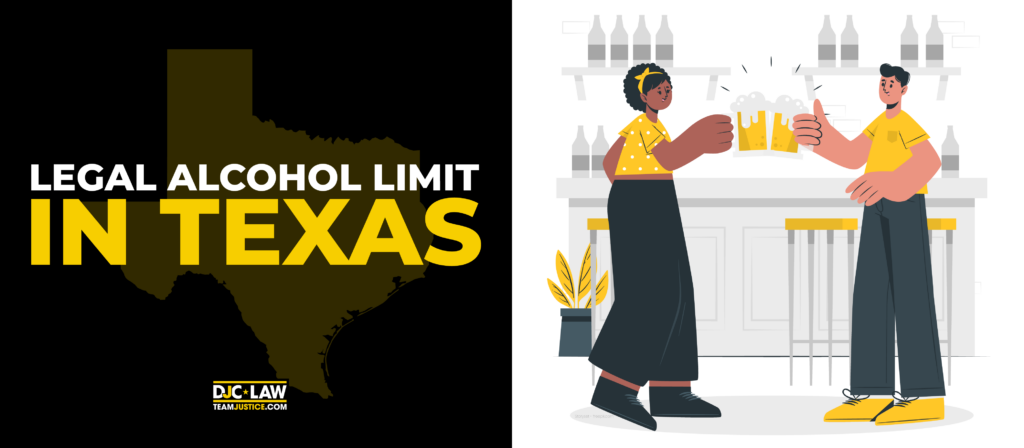
In this guide, we discuss the blood alcohol limits, the penalties for being caught drunk driving, and what to do if you’re in an accident with a drunk driver.
Key Takeaways
-
The legal blood alcohol limit in Texas is 0.08% or 80 milligrams of pure alcohol per 100 milliliters of blood.
-
Commercial drivers have a lower Blood Alcohol Concentration (BAC) limit of 0.04%, with offenders potentially seeing their commercial driving licenses permanently suspended.
-
A 0.08% BAC isn’t a strict number of drinks because your BAC depends on factors like age, gender, weight, and drinking habits.
-
Underage drivers cannot have any detectable alcohol in their blood, according to the Zero Tolerance Statute.
-
Penalties for drunk driving offenses range from fines and community service to license suspensions and jail time, depending on the number of previous convictions and other aggravating factors.
-
If you’re involved in an accident with a drunk driver, it’s vital to record your injuries, call law enforcement, and consult a lawyer to begin building your case.
What is the Legal Blood Alcohol Limit in Texas?
The legal blood alcohol concentration in Texas is 0.08%, as set by Sec. 49.04 of the Texas Penal Code. Surpassing a blood alcohol level of 0.08% means you could be charged with drunk driving, which could result in fines, your license being suspended, or even jail time.
Note that an officer can still arrest you, even under this limit, for driving with an impairment to your mental or physical faculties. If a traffic officer believes you’re impaired mentally or physically after conducting a field sobriety test, they can arrest you.
This caveat is in the law because everyone reacts differently to alcohol, meaning even if you don’t surpass the blood alcohol limit, you could still be driving recklessly. It helps law enforcement officers to try to stem the tide of impaired drivers. According to the State of Texas Open Data Portal, from 2014 to 2023, 37% of all traffic fatalities involved drivers who were under the influence of drugs or alcohol.
What is a 0.08 Alcohol Level?
The 0.08% Blood Alcohol Concentration (BAC) measures how much ethyl alcohol is in your bloodstream using a percentage. The 0.08% level was chosen because this is when people show obvious signs of alcohol impairment. In other words, they have 80 milligrams of alcohol in 100 milliliters of blood.
Signs of a 0.08% BAC include:
-
Muscle Coordination – A person experiences minor movement issues, making it difficult to stand and walk straight.
-
Speech – Alcohol makes it difficult to control your speech, which is why impaired drivers often display slurred speech.
-
Vision – Drinking can cause blurred vision, making it difficult to see what’s in front of you, or cause the tunnel vision effect, which limits peripheral vision.
-
Reaction Times – Drivers with a 0.08% blood alcohol level will have slower reaction times, meaning they’ll take longer to react to hazards.
-
Decision Making – Alcohol consumption also lowers your inhibitions, making it likelier that you’ll engage in more risky behaviors, such as running red lights or driving faster than you usually would.
All of these factors begin to appear in most people at the 0.08% BAC level, which is why it was chosen as the universal upper limit for impaired driving by the federal government.
What Factors Lead to BAC?
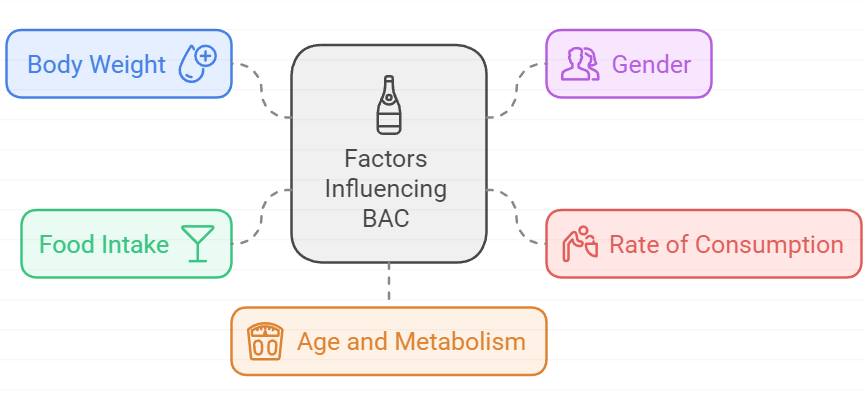
Your BAC after X number of drinks depends on the person because people have different alcohol tolerances. Such factors might include rate of consumption, weight, gender, and age. It’s why the scientific BAC measure was chosen rather than simply asking how many alcoholic beverages someone had.
Let’s list the factors that influence how high your BAC may be after consuming alcohol:
-
Body Weight – People with higher body weights have higher blood volumes, which helps to dilute alcohol. This is why an underweight individual will have a higher BAC after one beer than an overweight individual after the same amount.
-
Gender – Different body compositions between the genders influence BAC. Even if a man and woman are the same height and weight, they’ll have different BACs.
-
Rate of Consumption – Faster drinking spikes your blood alcohol levels faster than consuming the same amount over a longer period.
-
Food Intake – Eating food before drinking means you become intoxicated slower because the presence of something in your stomach slows down how quickly alcohol is absorbed into the bloodstream. Naturally, this also applies to your blood alcohol levels.
-
Age and Metabolism – Your age, drinking habits, and genetics influence how quickly alcohol is metabolized. It’s why non-drinkers get intoxicated faster than regular drinkers. Generally, Bowling Green State University reports that your BAC level will drop by an average of 0.015 per hour, or one standard drink per hour in men. However, this can be faster or slower based on how efficient your metabolism is.
Of course, the more alcohol you consume, the higher your BAC will be. There’s a vast difference between drinking a can of Budweiser and downing a glass of vodka or Jack Daniels.
How to Calculate Your BAC
You can calculate your own BAC by using the Widmark Equation. Note that any formula is only an estimation and shouldn’t be considered a substitute for comprehensive testing, such as taking a blood test or using a breathalyzer.
According to the Master Center for Addiction Medicine, alcohol absorbs into your system in as little as 10 minutes, but the effects don’t peak until 30-90 minutes after ingesting it. Assuming that all alcohol has been absorbed into your system, we can use the Widmark Equation.
Indiana University provides the equation as follows:
BAC = (Dose in grams/(body weight in grams x distribution ratio “r”))x100
The distribution ratio, or “r,” is .68 for men and .55 for women. The formula also assumes that your BAC sees a reduction of 0.016 BAC per hour. It’s a simplified formula, and you’ll find plenty of calculators online. Still, with so many factors impacting BAC, it’s not a formula to rely on when considering whether you can drive.
How Many Drinks Can You Have and Drive in Texas?
No chart or rule of thumb is accurate enough to estimate how many drinks you can have and still be okay to drive because everyone’s body deals with alcohol differently. Generally, you should avoid drinking entirely if you’re going to drive to be on the safe side.
However, if we’re assuming a standard alcohol drink in the average person, this might be 4-6 cans of 355 ml 5% ABV beer for men and 2-5 of the same beers for women. These numbers are estimates and shouldn’t be relied on if you’re deciding whether you’re capable of driving safely.
Alcohol Legal Limit Chart
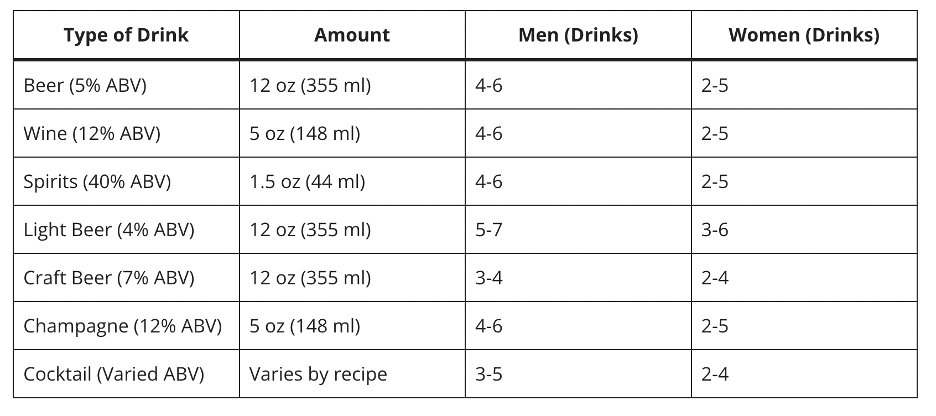
Is There a Different Alcohol Limit for Drivers Under 21 in Texas?
Texas operates on a zero-tolerance policy for drivers under the age of 21. The Texas Department of Public Safety states that, unlike adult drivers, younger drivers cannot drive with any detectable alcohol in their bloodstream. Even a single beer is enough to put them over the limit.
The Texas zero-tolerance policy for minors was introduced to attempt to stem the tide of underage fatalities caused by alcohol and drugs. According to ABC13, Houston, Texas, has the third highest rate of underage drunk drivers involved in fatal auto accidents.
Understanding the Zero-Tolerance Policy
The Lone Star State’s Zero Tolerance Law applies to anyone driving on a public road in the state. No underage driver can have any detectable alcohol amount in their system. Drivers do not have to hold a Texas driving license or be a state resident to fall under this law’s jurisdiction.
The reasoning behind this Texas law is that nobody under the age of 21 is allowed to drink any sort of alcoholic beverage. Since it’s illegal for minors to drink, the state makes it prohibited to drive any motor vehicle, boat, or plane with any alcohol in their blood.
Plus, the Zero Tolerance Law applies to any form of controlled substance in your system, whether legal or illegal. Technically, if you’re consuming a prescription medication, you could still face charges if you’re under 21, even if you have a doctor’s note.
Penalties for Underage Drinking and Driving
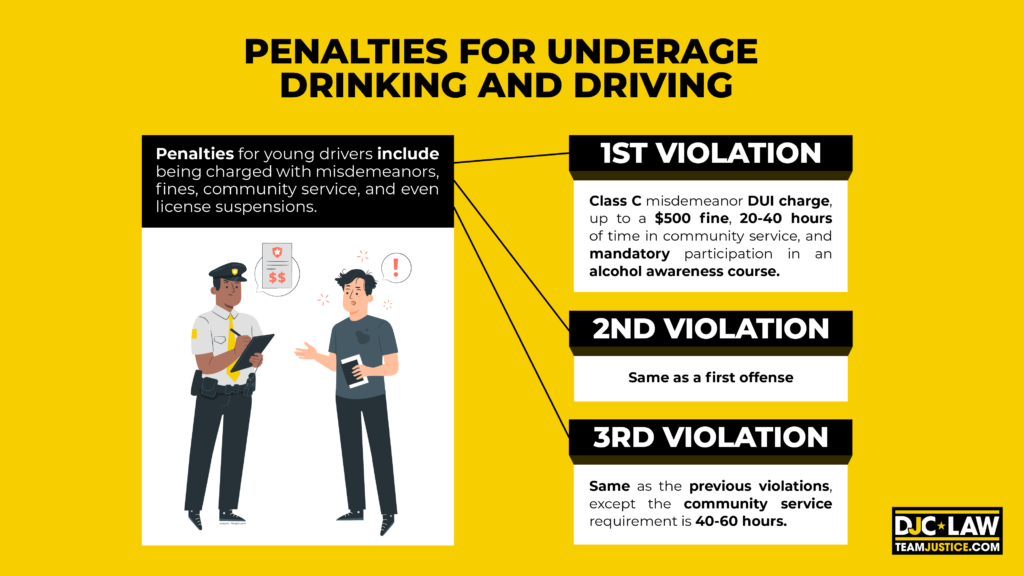
Penalties for young drivers include being charged with misdemeanors, fines, community service, and even license suspensions. The penalties depend on the number of violations, violation severity, and any other aggravating circumstances.
Here are the penalties:
-
First Violation – Class C misdemeanor DUI charge, up to a $500 fine, 20-40 hours of time in community service, and mandatory participation in an alcohol awareness course.
-
Second Violation – The same as a first offense.
-
Third Violation – The same as the above, except the community service requirement is 40-60 hours.
Note that there are other potential penalties. For example, a judge may require you to have an ignition interlock device put in your car, attend other classes, and even require the driver’s parents to take the same alcohol awareness courses.
Can You Lose Your Driving License Under the Zero Tolerance DUI Law?
All young drivers will have their licenses suspended if they violate the Zero Tolerance Statute. How long you lose your license depends on how many offenses you’ve committed.
Here’s how long you can expect to lose your license for:
-
First Violation – 60-180 days
-
Second Violation – 120 days to two years
-
Third Violation – 180 days to two years
In rare cases, it’s possible to keep your license, but you’ll need to attend a license suspension hearing. You’ll have the opportunity to build a case and explain why you shouldn’t lose your license.
What is the Legal Alcohol Limit for Commercial Drivers in Texas?
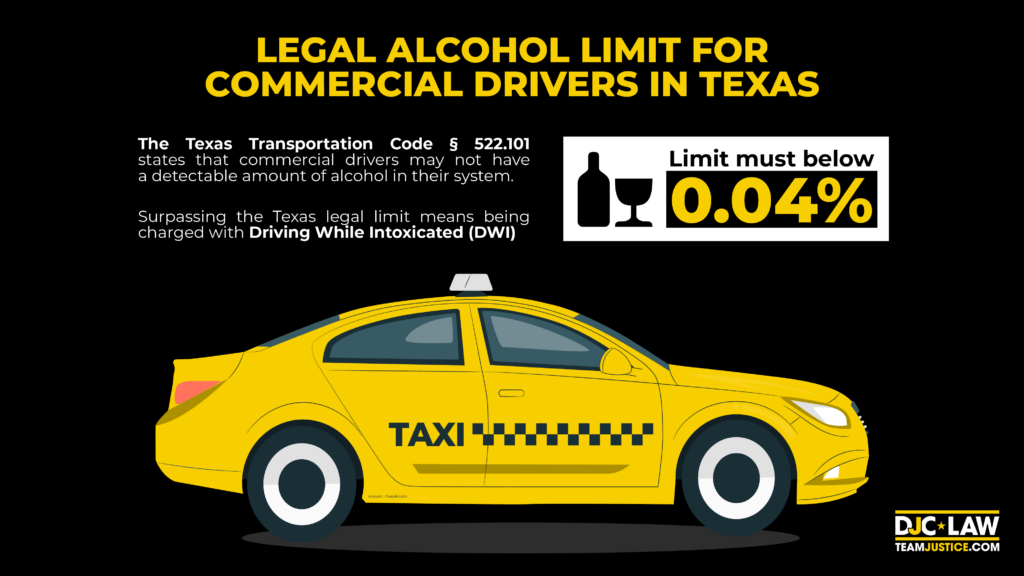
The Texas Transportation Code § 522.101 states that commercial drivers may not have a detectable amount of alcohol in their system. In practice, this means their legal BAC limit must be below 0.04%. Surpassing the Texas legal limit means being charged with Driving While Intoxicated (DWI).
Texas follows federal direction on its commercial driving limit, with the Federal Motor Carrier Safety Administration (FMCSA) also mandating a 0.04% limit. The stricter limit has been implemented because of the increased likelihood of serious injury and death in accidents involving commercial vehicles.
Generally, to count as a commercial vehicle, it must meet one of three characteristics:
-
The vehicle weighs 26,000 lbs. or more.
-
The vehicle is designed to carry 16 or more passengers.
-
The vehicle is carrying hazardous materials.
How are Commercial Drivers Regulated?
Texas commercial drivers follow the rules set by the FMCSA, but it’s up to the state’s traffic officers to enforce said regulations. Employers may also have additional regulations that apply to their drivers.
Businesses with commercial drivers often have more stringent regulations to protect against the risk of a driver being intoxicated. Examples include random drug testing, ignition lock devices, and immediate termination if they’re charged with a DUI or DWI offense. However, it’s largely up to businesses to regulate their fleet.
Possible Ramifications for Breaching the Alcohol Limit
Commercial drivers face the same penalties as non-commercial drivers, but additional consequences can apply. You risk losing your commercial driver’s license through suspension or even permanently.
Aggravating factors could also see what’s ordinarily a misdemeanor elevated to a more serious misdemeanor or even a felony. Getting charged with a felony class offense could result in mandatory jail time.
Additionally, you may be terminated as a commercial driver for surpassing the legal alcohol limit, which can make getting another job difficult, if not impossible, in the future.
Commercial license suspensions for drivers are as follows:
-
First Offense – Suspension of up to one year.
-
Second Offense – Potential lifetime suspension.
However, the Texas Department of Public Safety states that a lifetime commercial driving license suspension can be overturned after ten years in some cases.
What are the Methods of Testing Blood Alcohol Content (BAC) in Texas?
Blood and breathalyzer tests are the standard testing methods for BAC in Texas. Traffic officers may immediately ask for a sample to decipher your BAC, but they may also conduct a roadside sobriety test first.
Note that a BAC test is only an indicator of whether to charge you with a DUI or DWI. It doesn’t necessarily mean you’ll be convicted, but BAC test results are often the foundations of successful cases.
Can I Refuse a Blood Alcohol Test in Texas?
You have the statutory right to refuse to provide a breath or blood sample, but this comes with consequences and exceptions.
Firstly, the implied consent law means you’re required to take a breath or blood test if you’ve been arrested for being intoxicated at the wheel, with the arresting officer deciding on which test. However, the same law allows you to refuse to take either test.
The exceptions to the right to refusal include:
-
If the suspected DWI is related to a serious injury or death.
-
If you’ve had two previous DWI convictions.
-
If a previous DWI conviction involved a serious injury or death.
It’s rarely a good idea to exercise your right to refusal because this will result in the immediate suspension of your driver’s license. How long it’s suspended depends on the number of offenses:
-
First Offense – 180 days
-
Second Offense – Two years
-
Third Offense – 10 years
Your license will be confiscated at the roadside, and you’ll be issued a 41-day temporary permit. You’ll have 15 days to challenge your license suspension.
Types of Alcohol Testing Devices
At the roadside, you’ll be asked to blow into a breathalyzer device. However, if you opt for a blood test, this will be conducted in a controlled environment, such as a medical facility or a law enforcement agency.
-
Breathalyzer Test – This device estimates BAC by measuring the alcohol in a person’s breath. It’s a fast, convenient, and portable way of reading a person’s BAC, but they’re known to provide false readings.
-
Blood Tests – These tests are conducted in a controlled environment by qualified professionals. It’s widely viewed as the most accurate BAC measurement option.
Urine samples used to be standard for testing BAC levels, but as the least accurate testing option, they’ve been largely phased out.
Accuracy and Reliability of BAC Tests
No BAC test is 100% reliable, and having a BAC level over the limit doesn’t guarantee a conviction. Countless cases have been won by questioning the accuracy and reliability of these tests through false positives, which is why urine tests were phased out entirely.
Here are the factors that can influence accuracy for each test:
-
Breath Test – Calibration errors, improper administration, and medical conditions.
-
Blood Test – Sample mishandling, chain of custody errors, and equipment malfunctions.
That’s why it’s vital to have an Austin personal injury lawyer on your side if you believe you’ve been unfairly charged. Your San Antonio Car Accident Lawyer can question the validity of the tests and ensure justice is done.
What are the Penalties for Driving Under the Influence in Texas?
Driving while intoxicated represents a massive portion of fatal accidents in Texas, which is why the penalties for driving drunk include fines, license suspension, and even jail time. Aggravating circumstances could upgrade your charges from misdemeanors to felonies, resulting in jail time.
Let’s go through the penalties according to the Texas Department of Transportation:
First-Time DWI Offense Consequences
-
Maximum $2,000 fine
-
Maximum 180 days in jail.
-
Three days of mandatory jail time.
-
Maximum one-year license suspension.
Second-Time DWI Offense Consequences
-
Maximum $4,000 fine.
-
1-12 months of jail time.
-
Maximum two-year license suspension.
Third-Time DWI Offense Consequences
-
$10,000 fine.
-
2-10 years of jail time.
-
Maximum two-year license suspension.
DWI Offense Consequences With a Child Passenger
Committing a DWI with a child under the age of 15 in the car means you’ll face extra penalties regardless of whether you’ve been convicted of a DWI previously. Penalties include:
-
Child endangerment charge (automatic felony).
-
Additional $10,000 fine.
-
Additional jail time of up to two years.
What to Do if You’re in a Car Accident Involving a Drunk Driver
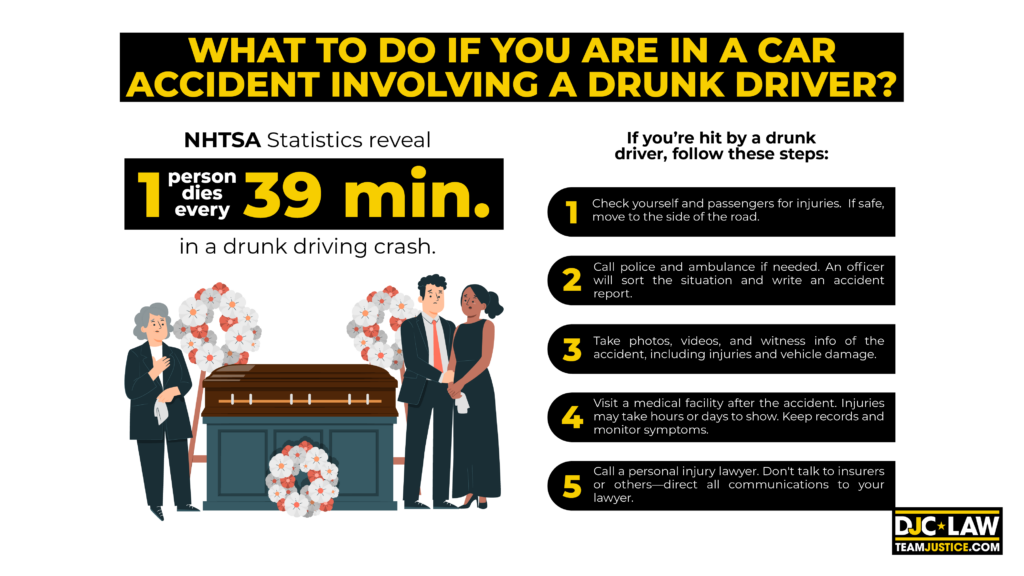
Getting into an accident is more common than you think. National Highway Traffic Safety Administration (NHTSA) statistics reveal one person in the U.S. dies every 39 minutes in a drunk driving crash.
If you’re hit by a drunk driver, follow these steps:
-
Step One – Check yourself and your passengers for injuries. If it’s safe to do so, move to the side of the road.
-
Step Two – Call the police immediately and an ambulance, if necessary. A law enforcement officer will arrive to sort out the situation and write an official accident report.
-
Step Three – Take pictures and videos of the accident, including injuries and the vehicles involved. You can also gather eyewitness reports, taking down their contact information in the process.
-
Step Four – Attend a medical facility after the accident to get checked. Many injuries don’t appear until hours or even days after the accident. Keep all documentation and monitor your symptoms over the next few days.
-
Step Five – Call a San Antonio personal injury lawyer to begin building your case. Don’t talk to anyone else, including insurers, about your accident. Direct any communications to your lawyer.
If you’re injured in an accident with a drunk driver, you’ve got the right to file a personal injury claim against the other driver for economic and non-economic damages. Note that in Texas, you might be able to sue not only the drunk driver but also the bar that served the alcohol in the first place.
Your Austin drunk driving lawyer will investigate every avenue and file cases against every liable party to maximize your settlement.



